

Article: Commander Colonel, Dental Corps, Dr. Sven M. Funke
EUROPEAN CHALLENGE 2020
“Together we are strong!”
From the multinational Medical Task Force EUROPEAN BATTLEGROUP 2020-2
Introduction
Originally, it was intended for the central certification of the EUROPEAN BATTLE GROUP 2020-2 (EUBG 2020-2): From 2 to 25 March, the large-scale exercise EUROPEAN CHALLENGE 2020 was planned to take place at the WILDFLECKEN and HAMMELBURG major training areas (MTA) as well as in the areas of GIEBELSTADT, VOLKACH, and KUELSHEIM.
However, before the “hot phase” could actually begin, planning - literally - turned into a European challenge. Owing to the corona pandemic, an increasing number of nations cancelled their participation. In the end, even the decision had to be made not to deploy troops any more, to cancel all planned “real” exercise phases, and to train the required processes “at the green table” instead. No troops at all? No! Against all odds, one formation used the opportunity to train and to have itself finally evaluated for the upcoming EUBG 2020-2 standby phase ...
EUROPEAN BATTLEGROUP 2020-2
On 1 July 2020, the standby phase of the 51st European combat unit, EUBG 2020-2, will begin. It is to last until late January 2021. The DEU Army Rapid Response Forces Division (RRFD) from STADTALLENDORF was designated as lead division and will provide the force headquarters (FHQ). The Multinational Joint Headquarters ULM (MN JHQ Ulm) will assume the role of higher operations headquarters.
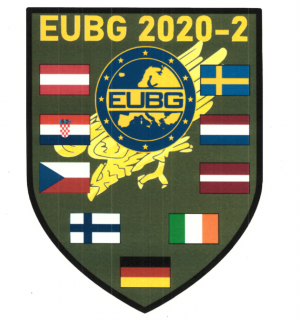 Coat of arms of the EUROPEAN BATTLEGROUP 2020-2
(Source: Rapid Response Forces Division)
Coat of arms of the EUROPEAN BATTLEGROUP 2020-2
(Source: Rapid Response Forces Division)
The core battlegroup of the combat unit is formed from an airborne manoeuvre battalion and consists of:
• six paratroop companies (3x DEU, 2x NLD, and 1x CZE), as well as
• one DEU-NLD airborne reconnaissance company,
• one IRL-DEU airborne engineer company,
• one DEU-NLD airborne combat service support company,
• one DEU-NLD airborne medical company - as part of the organic Army Medical Service (AMedS),
• one DEU-SWE NBC defence platoon, and
• one DEU reinforced air defence platoon
For combat service support purposes, also included are:
• a Medical Task Force (MedTF), the deployed medical battalion,
• a multinational military police company (MP coy) consisting of DEU, AUT, and CZE forces,
• a FIN reconnaissance platoon (recce plt),
• a DEU-AUT CIMIC support unit for civil-military projects, and
• a multinational psychological operations support element (PSE).
Logistic support is provided by:
• an AUT-led combat support service battalion,
• a national element, the national support element (NSE), as well as
• organic supply and transport elements.
The second particularity of this EUBG 2020-2 is that a highly mobile formation of the German Army, like RRFD, will be provided medical support to by a line regiment of the Bundeswehr Joint Medical Service (BwJMedS) with modular medical treatment facilities (MMTF). We will detail on these challenges later ...
Multinational Medical Task Force (MN MedTF)
Together with fellow-soldiers of the medical services of the Austrian Armed Forces, the Army of the Czech Republic, and the Swedish Armed Forces, 2 Medical Regiment (Med Regt) WESTERWALD from RENNEROD will provide the MN MedTF in the second half of 2020, the Medical Task Force EUROPEAN BATTLEGROUP 2020-2 (MedTF EUBG 2020-2).
This MedTF comprises 360 service members who accomplish their mission in a “classical” organisation. This includes:
The Medical Service Logistic Support Point
which on operations represents level 1 logistic support for the entire task force.
The focus here is the service and support company of 2 Med Regt WESTERWALD, which turns into a Combat Service Support (CSS) coy. This company is designed to ensure ideal parameters for operational readiness and capability of medical treatment facilities (MTF) for and on missions abroad. To this end, the CSS coy inter alia provides for the essential common service and support tasks for the entire task force, as for instance supply of water, POL (petroleum, oils, and lubricants) and associated products, IT and communication links, or transportation services.
In the field of functional and technical support, the CSS coy is reinforced by a medical logistics squadron of Medical Logistics Centre (MedLogC) BLANKENBURG. This squadron is responsible for the entire “specialist logistics”, from the individual dose of medication, to oxygen supply, through to the maintenance and repair of medical equipment.
The personnel strength of the Medical Service Logistic Support Point is 150.
The Medical Evacuation Company (MEDEVAC coy)
which is tasked with ground medical evacuation of wounded, injured, and sick persons (patients) from the place where damage control resuscitation (DCR) is provided to the fighting force – the mobile aid station (MAS) (Role 1) – to the facility where damage control surgery (DCS) is provided – the mobile surgical hospital (MSHosp) (Role 2). Over long distances, transport capability is ensured by setting up ambulance exchange points (AXP).
The MEDEVAC coy is staffed with highly qualified medical assistance personnel who will be reinforced on operations by medical specialists experienced in emergency and rescue medicine. Materiel and equipment are highly mobile as required by the mission. In addition to the five DEU medical teams, two AUT protected mobile emergency physician teams (MEPT) - with DINGO - have been integrated into the mobile set of forces. Furthermore, an aeromedical evacuation (AE) team for tactical AE - primarily with CH-53 MEDEVAC - is kept available.
Taking account of the “special role” of RRFD, the unit is reinforced by its own Role 1 capability for the immediate provision of organic medical care for FHQ EUBG. To this end, Medical Squadron (MedSqn) BISCHOFSWIESEN of Medical Support Centre (MedSC) MUNICH is assigned to the MEDEVAC coy.
Personnel strength of the reinforced MEDEVAC coy is 50.
The mobile surgical hospital (MSHosp) (Role 2 Enhanced/R2E)
The primary task of this Role 2 MTF on operations is to provide damage control surgery (DCS) to patients from the area of operations. In addition, the portfolio of this MTF includes comprehensive shock treatment, intensive care, a limited capability of further diagnosis, and general nursing. Medical/dental, as well as outpatient and clinical specialist treatment supplement the spectrum of performance.
Here, too, multinationality is an important approach. Members of the medical service of the AUT Armed Forces, for instance, support with one team each the “emergency room/shock treatment”, “intensive care”, and “nursing” areas. In addition, one nurse each of the medical services of the Army of the Czech Republic and the Swedish Armed Forces reinforce the nursing ward.
Personnel strength of the R2E MTF is 120.
The Command Post (CP)
is in command of the individual units of the task force. At the same time, the CP is the point of contact (POC) for the division headquarters (HQ) leading the operation.
The CP mirrors the HQ of the task force with its primary staff func tions – S1: Personnel and leadership development and civic education, S2: Military security S3: Leadership and organisation, S4: Materiel and logistics, S6: IT/communication links.
AUT experts reinforce the CP elements also in the plans (S3) and combat service support (S4) field. The senior AUT officer at the same time exercises national command and control (C2) over the entire medical contribution provided by the AUT Armed Forces. Personnel strength of the CP is 30.
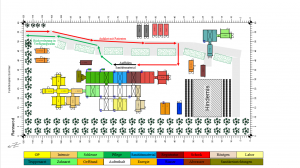 Layout of the MSHosp BLAUE HATZ (Source: Bundeswehr)
Layout of the MSHosp BLAUE HATZ (Source: Bundeswehr)
After 2 Med Regt WESTERWALD – one of currently four “line regiments” of the Bundeswehr Joint Medical Service (BwJMedS) – had been set as the core of the MN MedTF EUBG 2020-2, considerations started on the preparation of the upcoming standby phase. It was clear from the beginning in this context that significant personnel and materiel challenges would have to be mastered on the way there.
There have been extensive personnel changes in recent years. In many areas, duty routine almost came to a standstill, not only owing to a change of commander “during the race”, but also because of a huge “bloodletting” in personnel qualified and experienced in the processes and materiel.
Another significant issue since the formation of the regiment in 2015 has been materiel and equipment. Even today, entire companies in
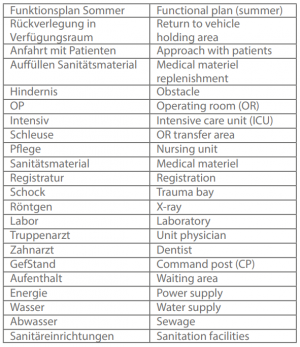
terms of quality and quantity are not equipped as required by the table of organisation and equipment (TOE).
Overall, this was not an easy starting position to
• Have the personnel and materiel of the regiment “combat ready” for the MN MedTF EUBG 2020-2,
• Establish with the DEU personnel and materiel portion the core capability of all functions of a MN MedTF,
• Create the basis for integrating the personnel and materiel support provided by several Allied European medical services,
• Prepare and enable evaluation of this particular operational structure in the context of a large-scale exercise, and to
• Achieve certified preparedness of this multinational task force to ensure the provision of medical support to a European battle group in all its scenarios
• within two and a half years.
In anticipation of the order of battle (ORBAT) to be prepared by RRFD to determine the number of forces and their organisational assignment, extensive preparatory work started at 2 Med Regt WESTERWALD, already.
The specialist qualifications and capabilities required for a MedTF to support a highly mobile battlegroup were compiled in a draft of tailor-made lists of billets and provided with first ideas on personnel and materiel.
Based on the lessons learned from EUBG 2016, hence, the image of a DEU core element of a MedTF quickly formed. However, it also became clear soon that this task could not be accomplished nationally alone, but that the European medical partners would have to provide their share regarding the provision of personnel and materiel. Beside these preparations, also deployment training of the personnel had to be pushed on with. One advantage of a standing medical unit is that mission accomplishment in routine duty in Germany regularly also serves to maintain military proficiency of its specialist personnel. Therefore, the decision came naturally to train the setup of an MSHosp as intended for the EUBG. Hence the regimental exercise “BLAUE HATZ” was born.
BLAUE HATZ
Owing to the limited areas available at ALSBERG barracks in RENNEROD and the difficult parameters shortly before the renewed materiel management inspection in the unit announced for November 2019, the decision was made to set up only the essential modules of the MSHosp
Added to that, clinical personnel of the Bundeswehr Central Hospital (BwCenHosp) KOBLENZ was not available for the exercise phase owing to the summer holidays in RHINELAND-PALATINATE. Here, the significance of our 5th company, the reinforcement reserve of 2 Med Regt WESTERWALD, deserves particular mentioning because our fellow medical specialists and the medical assistance personnel were highly motivated and ensured the functioning of the facility within the scope of reserve duty – and, thus, contributed significantly to the success of the exercise.
EUROPEAN FALCON 2019
In the second half of October 2019, RRFD conducted the exercise EUROPEAN FALCON 2019 at MTA BERGEN. Beside the possibility of general, national but also multinational, military training activities being conducted by the core battlegroup – in the focus here was the DEU-NLD airborne unit and a few combat support elements – training of the FHQ RRFD was to focus in particular on its internal processes. To this end, the facility was extended by so-called “response cells” of the other forces of the EUBG, notably medical service and logistics.
The MN MedTF was represented on site with all its capability areas and supported the GMED staff division, especially in the implementation and rehearsal of the various processes of patient flow management in the patient evacuation coordination cell (PECC). Another important goal of EX EUROPEAN FALCON 2019, however, was to develop an appropriate operational scenario as the basis for the required generic planning of EUBG deployment. Resulting were two findings that are also important for the further preparation of the MN MedTF:
1.)
A maximum of three day’s marches of 200 km each was planned for deploying into the then still assumed East African area of operations (AOO). In this phase, the medical evacuation chain is heavily stretched during the leapfrogging setting-up of a Forward Operating Base (FOB) after debarkation of the personnel at the airport of debarkation (APOD) and of the materiel at the seaport of debarkation (SPOD).
In order to meet the relevant timelines of medical care by means of a sound CH-53 support to aeromedical evacuation (AE) during an operation, though, a facility for damage control surgery (DCS) was planned according to a Forward Surgical Element (FSE).
Since neither the TOE of 2 Med Regt WESTERWALD nor that of the other multinational elements do provide for such an FSE in personnel or materiel terms, a protected MAS of the MEDEVAC coy will be charged with this specialist task during an operation. For this purpose, the MAS will be staffed with one of the two surgical teams and, in materiel terms, will be enhanced by a basic DCS capability.
Upon arrival at the Main Operating Base (MOB), the second surgical team in the same configuration and with the same task will take over DCS in a prepositioned MAS of the core battlegroup.
When all forces are concentrated in the MOB, the surgical team will finally shift to the R2E MTF of the MN MedTF.
2.)
In the course of EX EUROPEAN FALCON 2019, the very different operational doctrines of RRFD on the one hand and 2 Med Regt WESTERWALD on the other became manifest repeatedly. The focus was on the differing temporal ideas and different procedures already during deployment, but in particular, when full operational capability (FOC) was established.
Considerations on how to optimise things were mainly driven by the endeavour to ensure the provision of both: required, preferably continuous DCS as well as quick and comprehensive medical care.
Initial Operational Capability
In the course of the outlined considerations, initial operational capability was adapted to the system of MMTFs and the specific materiel resources of 2 Med Regt WESTERWALD.
All participants were aware that the options for internal further development are quite limited in a battlgroup with MMTFs.
At the beginning, the required medical capabilities of the element were specified:
• Emergency room, including triage and treatment of shock,
• Diagnosis,
• Emergency surgery,
• Intensive care,
• Holding capacity,
• Materiel storage site.
Owing to the largely standardised setup procedure of an ideal MSHosp, the option of a variant emerged during further considerations that is adapted to the specific technical guidelines of the Bundeswehr Medical Service (BwMedS) as well as to the operational and tactical requirements of RRFD. Based on these planning fundamentals, admission and operation readiness within six hours was defined and specified for materiel configuration.
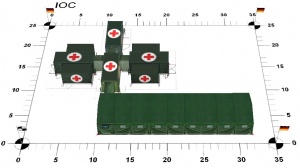 Layout of Initial Operational Capability
(IOC; Sergeant Jens Horst, Bundeswehr/Site Planning Tool, Airbus)
Layout of Initial Operational Capability
(IOC; Sergeant Jens Horst, Bundeswehr/Site Planning Tool, Airbus)
This approach then had to be implemented in the medical companies of the formation, making use of the extensive experience and individual expertise. Here, not only the pure setup plan was in the focus. Also the other factors that had to be considered were taken into account, as for instance the packing and stowing of equipment and its transportation by appropriate transport and delivery vehicles. This task developed into a multidisciplinary challenge for the entire formation: Senior Medical Service officers (SMedSO), the senior maintenance officer, nurses of most different specialisations, setup managers, personnel entrusted with cargo-securing tasks, specialists in public law tasks, water specialists, crane operators – everybody was extremely committed. And everybody knew, that only little time remained to find a solution and to implement it within the scope of the upcoming large-scale exercise. There would not be another trial prior to the exercise, it had to come off at one go!
In the end, an approach emerged that was to ensure that IOC was established within six hours but also the steady continuation and conclusion of the further setup of the other capabilities of the MSHosp – and thus to achieve full operational capability (FOC) – within 72 hours.
DEU-AUT Cohesion Exercise
In accordance with the multinational approach of the EUBG, a combined cohesion exercise with the medical service of the AUT Armed Forces, the strongest contingent in qualitative and quantitative terms, was planned for December 2019.
This at the same time provided the framework for testing the EUBG’s IOC concept to improve the establishment of operational capability of MMTFs at least in the setup and initial in-service phases. During one week, 15 AUT fellow soldiers could familiarise with the MMTF system, exchange views across all specialties of a Role 2E MTF, discuss the particular requirements put on the camp support platoons as prerequisite for the setup and operation of the MTF, and coordinate procedures and processes within the PECC to be planned within the FHQ. Furthermore, the command personnel of both medical services could answer questions of the EUBG leadership and harmonise principles and procedures for and on operations.
It was a successful event, that served to understand common parameters and prerequisites regarding both the EUBG and the upcoming certification exercise EUROPEAN CHALLENGE. Furthermore, it offered the opportunity for those bearing technical and/or command responsibility for important (sub-) areas of the MN MedTF to get to know each other personally. Once again, the common spirit manifested, which both medical services feel committed to and which has proved to be a technically fundamental and always reliable element in many contingents already.
Planning cycle EUROPEAN CHALLENGE 2020
The planning cycle for EX EUROPEAN CHALLENGE 2020 as certification exercise for EUBG 2020-2 ran in parallel to the Medical Service preparations. Intent of the Commander, Rapid Response Forces Division (CDR, RRFD) was to train in particular the processes and procedures of the FHQ in a live exercise (LIVEX) involving the forces on site. Independent evaluation portions were admitted for the core battlegroup, combat support, combat service support, and logistics elements, but were not the focus.
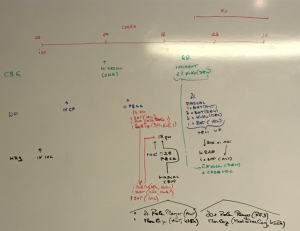 “Medical play” EUROPEAN CHALLENGE 2020
(Source: Colonel, Dental Corps, Dr Sven Funke, Bundeswehr)
“Medical play” EUROPEAN CHALLENGE 2020
(Source: Colonel, Dental Corps, Dr Sven Funke, Bundeswehr)
Actually, the limits due to the dimension of the exercise scenario became apparent repeatedly in the course of the planning process. Owing to the number of participating forces, thus, the exercise area for EUROPEAN CHALLENGE 2020 had to be stretched over several garrisons. Beside the main training areas WILDFLECKEN – for the command and control (C2) organisation, i. a. FHQ RRFD – and HAMMELBURG –i. a. for the AUT CSS battalion – the garrison areas KUELSHEIM and VOLKACH were set as exercise areas of the core battlegroup and GIEBELSTADT as conceived APOD. Also the very different medical care and operational concepts – the organic Army Medical Service of RRFD with an extended Role 1 capability on the one hand, and the Bundeswehr Joint Medical Service (BwJMedS) with a line regiment equipped with an MMTF on the other – had to be harmonised in the course of the planning cycle. A particular focus here was on resolving interface issues and defining handover processes. This was not an easy task for the DEU-NLD Division Surgeon/GMED division of RRFD!
In addition, the particular materiel requirements of 2 Med Regt WESTERWALD had to be taken into account. The need for an appropriately large, plane and hardly inclined installation site for the R2E MTF, thus, left only little leeway regarding the distribution of the available areas. Extensive site surveys and arrangements with all organisations on site that were involved or had to be involved, in the end led to a sound result accepted by all parties. The particular commitment, the understanding and solution-oriented approaches of the supporting elements, above all at HAMMELBURG garrison (Infantry Training Centre (ITC)) and VEITSHOECHHEIM garrison (HQ 10 Armoured Division (10 AD)) – from the respective command personnel, to the garrison senior officer (GSO), to the responsible Bundeswehr service centre – must be clearly emphasized, though.
During the Final Coordination Conference, a “medical play” was prepared, with due consideration of the different scenarios. It took into account the requirements of all interest groups involved in the exercise: the organic Role 1 medical care of the core battlegroup during the different exercise phases, the RRFD Division Surgeon/GMED division holding overall responsibility, but also the MN MedTF EUBG.
The comprehensive coordination efforts also resulted in an adaptation in the organisation of the operational areas. Since the distance of 105 km between the individual exercise areas of the core battlegroup – VOLKACH, KUELSHEIM, and GIEBELSTADT – and the R2E MTF in HAMMELBURG from a medical tactical perspective proved too long for end-to-end ground medical evacuation, the decision was made to establish an ambulance exchange point (AXP) in VEITSHOECHHEIM. This not only gave a significantly more realistic picture but also met the conceptual requirements of the Bundeswehr Medical Service. In case transportation times/routes are that long, these requirements provide for repeated triage and possibly renewed stabilisation of the patients to maintain or re-establish fitness for transport. This exercise design not only provided for an opportunity to train for the MEDEVAC coy, but also for an effective loss in combat power on the spot – owing to the extraction of the role players from the core battlegroup – the military leaders had to cope with within the scope of their mission accomplishment. However, the MN MedTF EUROPEAN CHALLENGE 2020 had to master the implementation of this adaptation alone. It was not taken into account in the planning, command and control, and support process of the Rapid Response Forces Division.
After completion of the planning cycle, the organisation of the operational areas, hence, provided for the following deployment of forces.
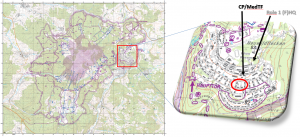 Deployment of the Medical Task Force at WILDFLECKEN garrison
(Source: Bundeswehr)
Deployment of the Medical Task Force at WILDFLECKEN garrison
(Source: Bundeswehr)
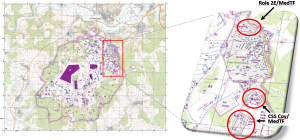 Deployment of the Medical Task Force at HAMMELBURG garrison
(Source: Bundeswehr)
Deployment of the Medical Task Force at HAMMELBURG garrison
(Source: Bundeswehr)
 Deployment of the Medical Task Force at WILDFLECKEN garrison
(Source: Bundeswehr)
Deployment of the Medical Task Force at WILDFLECKEN garrison
(Source: Bundeswehr)
Evaluation Exercise EUROPEAN CHALLENGE 2020
The following weeks were marked by intensive work to complete all preparatory measures and to establish notice to move (NTM) status. Extensive packing and stowing trials at the garrisons of 2 Med Regt WESTERWALD not only served to further train the personnel employed, but also to optimise the loading and unloading processes in organisational and procedural terms.
Core element of the preparations was initial operational capability of the R2E MTF of the MN MedTF EUROPEAN CHALENNGE 2020 as ordered. Based on the experience of the DEU-AUT cohesion exercise, but also in due consideration of the “challenges” of the significantly more mobile conduct of operations identified in the cooperation with RRFD, detailed plans for the initial phase of the R2E MTF were adapted. The focus was shifted distinctly: from merely evaluating the speed of setup towards establishing IOC or the capability to provide medical care – under operational conditions! The reviewed concept now provides for:
• An “OR star”, consisting of
• 1x OR container,
• 1x surgery preparation container, and
• 1x access container,
• 3x type II standard tents as temporary infrastructure for the areas
• Emergency room/shock treatment,
• Intensive care,
• Nursing or intermediate care, and
• Materiel,
• 1x equipment supply container to ensure supply of the OR area with pressurised medical gases and water,
• 1x energy supply container to ensure supply of the initial element with power, as well as
• 1x cable network container to establish an electric power grid to operate the IOC infrastructure.
Owing to the contemporaneous large-scale exercise DEFENDER 20 to deploy a US division to the Baltic countries (straight through Germany and Poland), the planning process for the deployment of the MN MedTF EUROPEAN CHALLENGE 2020 had to be adapted considerably.
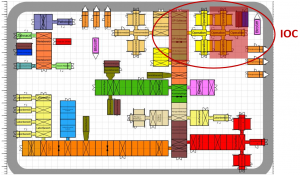 R2E MTF with IOC portion
(Source: Bundeswehr)
R2E MTF with IOC portion
(Source: Bundeswehr)
The commitment of forces resulted in significant delays in the Bundeswehr Logistics Centre (BwLOGC) in the issuance of movement credits for the individual march columns. Furthermore, neither was the Integrated Movement and Transport System of the Bundeswehr capable of providing support with tractor and trailer units, nor could military police forces convoy the march routes. In the end, plans were to deploy all equipment in two tours, exclusively using the entire vehicle pool of the regiment available. Preparations constituted a most impressive orchestration of an extensive but extremely smooth-running and divers gear work – to start with the precisely defined loading of the tractor and trailer units and the marking of their components and their movement in column formation into
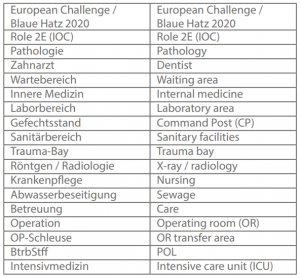
assigned marshalling areas at ALSBERG barracks in RENNEROD. Followed by the unloaded tractor and trailer units returning from the installation site in HAMMELBURG that had to be loaded again by our own “materials handling detachment” for another rotation (the only way to make sure that the legally required driving and rest times of the military drivers were complied with). Through to carrying out routine duty on site by a “team HOTEL”.
During the preparation phase, already, major adjustments were made to the national personnel and materiel resources of the MN MedTF EUROPEAN CHALLENGE 2020. The respectively responsible superior commands for instance decided not to bring in important clinical and public law specialists especially in the setup and initial phases of the R2E MTF, and not to provide for materiel and equipment relevant for the setup planning and the internal technical processes, either. Behind this decision were issues regarding the Working Time Act and budgetary guidelines on the sometimes comprehensive and expensive individually and bulk expendable items of supply relevant in terms of military medicine and pharmacy or food chemistry.
Beginning at midnight in the night between 2 and 3 March 2020, three march columns of 30 small vehicles and tractor and trailer units each left the barracks in the direction of WILDFLECKEN and HAMMELBURG. Four and a half hours later, personnel and materiel arrived safely at the exercise areas without any loss.
With the arrival of the first seven tractor and trailer units at the installation site at SAALECK barracks in HAMMELBURG, time ran for the setup of the R2E MTF. Despite significant personnel deficits, the different setup teams –”OR star”, container periphery, tents – interacted masterly within a sophisticated system. The responsible company commander was able to report IOC od the R2E MTF to CDR MN MedTF EUROPEAN CHALLENGE 2020 after six hours, and FOC after 72 hours. An impressive performance of all persons involved!
Immediately after the setup, preparations for evaluation started. Existing standing operating procedures (SOP) were reviewed during their implementation and adapted to the conditions of the R2E MTF of the MN MedTF EUROPEAN CHALLENGE 2020. The required technical processes of patient admission, diagnosis and care in the medical treatment facility were defined. These preparatory measures conclude with the development and training of a plan for a mass casualty situation, the MASCAL plan.
At that time, however, the corona pandemic already cast its shadows on EUROPEAN CHALLENGE 2020. Especially RRFD had to cope with the measures taken to avoid the spread of COVID-19: The rules on social distancing cannot easily be implemented in an FHQ; reduction of personnel inevitably results in a loss in competence and capabilities. Furthermore, several multinational partners decided not to deploy to GERMANY their exercise participants who still were in their respective home countries.
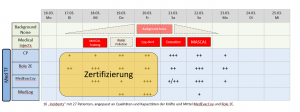 Scheduled phases of EX BLAUE HATZ 2020
(Source: Bundeswehr)
Scheduled phases of EX BLAUE HATZ 2020
(Source: Bundeswehr)
The MN MedTF EUROPEAN CHALLENGE 2020 was affected by this development, too. The CZE and SWE nursing personnel did not travel; the contingent of the medical service of the AUT armed forces was already on its way to HAMMELBURG when it was called back. The clinical personnel was held back in the Bundeswehr hospitals for the “real employment” that became ever more likely. Equally, the support personnel from the central institutes of the Bundeswehr Medical Service (CIPwMedS) and the supervisory centres for
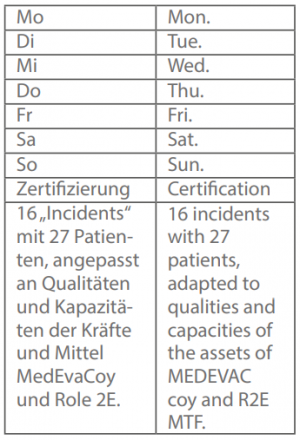
public law tasks of the Bundeswehr Medical Service (SC PLT BwMedS) in their respective institutes and centres prepared for a possible real “employment on German territory”. Likewise, MedLogC BLANKENBURG, essential part of the Medical Service logistic support point, could collocate only few elements of its range of services together with the CSS coy.
Thus, the personnel conditions for establishing, training, and finally evaluating the processes in the MN MedTF EUROPEAN CHALLENGE 2020 deteriorated increasingly. Especially in the R2E MTF, a coordinated preparation in particular of the MASCAL procedures now was out of the question. Starting from the “admis sion areas” triage, emergency and shock treatment, to radiology, through to OR, all medical specialist competences required were lacking. A realistic simulation of regular medical treatment, care, and assistance processes, thus, was not possible.
That was the hour of the reserve duty personnel of 5/ 2 Med Regt WESTERWALD. Their support even on few medical specialist positions became the medical specialist backbone of the medical care procedures in the R2E MTF trained. This contribution was supplemented by the outstanding performance of the many senior non-commissioned officers (SNCO), proven experts some of whom simulated medical specialist and organisational competences in order to contribute a minimum of realism to the exercise and evaluation procedures.
In the end, RRFD decided to slash the starting LIVEX to an extended command post exercise (CPX). Now the focus was on training the FHQ EUROPEAN CHALLENGE 2020, reinforced by response cells of the subordinate units. At the same time, it was determined to cancel the exercise elements of the other force contingents, which were to immediately redeploy to their home stations or to not even start deployment into the exercise areas.
At the same time, the planned exercise scenario had to be adapted to the new situation. The civilian role players of RRFD were dropped just like the incidents envisaged for the original exercise areas of the core battlegroup.
Before there was a chance to adopt the new exercise structure, RRFD cancelled EUROPEAN CHALLENGE 2020 completely. The remaining elements of the FHQ at WILDFLECKEN garrison redeployed immediately to the home station of the division, STADTALLENDORF in Hesse. A subsequent “small” CPX initially envisaged involving less and significantly smaller response cells of the subordinate units in the end had to be cancelled, too. Completed parts of the EUROPEAN CHALLENGE 2020 setup phase in the end were evaluated within HQ RRFD.
BLAUE HATZ 2020
In view of the fact that evaluation of the medical support of EUBG 2020-2 was upcoming and had to be pursued, CDR MN MedTF decided to
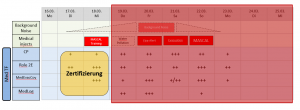 Actual course of EX BLAUE HATZ 2020 (Source: Bundeswehr)
Actual course of EX BLAUE HATZ 2020 (Source: Bundeswehr)
turn EX EUROPEAN CHALLENGE 2020 into an exercise of 2 Med Regt WESTERWALD. Without much effort and without the presence of medical support elements of multinational partners, hence, the personnel and materiel already in exercise mode on site as well as the appropriately designed processes of the MedTF could be employed for the evaluation process.
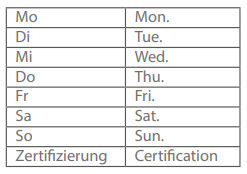
For this purpose, the originally multinational MedTF EUROPEAN CHALLENGE 2020 was “mirrored” into a (fictitious) national medical exercise BLAUE HATZ 2020.
At the same time, personnel not necessarily needed redeployed home in due consideration of the CORONA threat situation. This was in line with the provisions by the HAMMELBURG GSO for the military and civilian agencies at the garrison. The systematic implementation of the disaster alert declared in the federal state of BAVARIA for barracks and camps, as well as for HAMMELBURG MTA already entailed strong limitations for the exercising unit. This affected less the use of military infrastructure but above all the required support services by the Bundeswehr service centre.
EVALUATION OF THE MEDICAL TASK FORCE BATTLEGROUP 2020-2
Mid-March 2020, then, the MedTF EUBG 2020-2 was evaluated under the lead of the responsible Operational Medical Support Command (OpMedSCOM).
Beside the post-related fundamentals, like the standing operating procedures (SOP), the 11-member evaluation team from DORNSTADT, FELDKIRCHEN, LEER, MUENSTER, and WEIßENFELS, which was affected by the provisions to master the CORONA pandemic itself, checked in particular the entire procedure of the medical evacuation chain. From initial treatment of the exercise patients “in the field” by the medical team, to damage control resuscitation (DCR) at the AXP, through to triage, admission and stabilisation, as well as damage control surgery (DCS) and the subsequent provision of clinical care in the R2E MTF. In addition, the team considered and evaluated the management of the entire portfolio of medical support by the PECC.
The absence of the exercising elements turned out to be a big challenge. Owing to the discontinuation of the exercise, interaction between PECC and RRFD Division Surgeon/GMED division, for instance, could not be trained. The training and experience levels of the multinational personnel – each troop-contributing nation (TCN) had planned to provide at least one “dispatcher” (MedS SNCO), the Medical Services of the Bundeswehr and the AUT armed forces, additionally, would have integrated officers with operational experience into the PECC for EX EUROPEAN CHALLENGE 2020 – could neither be verified nor harmonised.
The general conditions for a reasonably organised course of the exercise that further deteriorated under CORONA in the end resulted in another adaptation of the exercise phases and, thus, the battle rhythm of EX BLAUE HATZ 2020. Only two complete days of exercise activities remained from the previously planned whole week! Therefore, “capable with limitations” was the result of evaluation. The evaluation team identified the following limitations:
1.)
Owing to the insufficient lead time, the standing operating procedures were not completely available and not fully adapted to the actual situation and procedures in the R2E MTF, and
2.)
There was a significant qualitative and quantitative lack of (specialist) personnel indispensable for a swift setup, comprehensive operation, and thus, reasonable process-related evaluation.
In the light of these limiting conditions decided by the superior commands, however, the evaluation result is “an extremely respectable achievement that will be reflected in a corresponding positive certification of the MedTF EUBG 2020-2.”
Conclusions
For 2 Med Regt WESTERWALD, EX EUROPEAN CHALLENGE 2020 was an experience beyond comparison – starting with the first considerations on the internal optimisation of the available modular equipment through to the evaluation result.
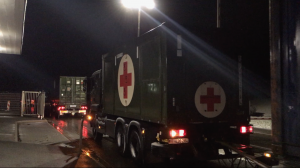 March column leaving ALSBERG barracks in RENNEROD
(Source: Colonel, Dental Corps, Dr Sven Funke, Bundeswehr)
March column leaving ALSBERG barracks in RENNEROD
(Source: Colonel, Dental Corps, Dr Sven Funke, Bundeswehr)
Never before have such dramatic and significant changes in the conditions, parameters and the course of a large-scale exercise occurred that was planned and prepared long before and thoroughly. And never before has such a degree of outstanding and unabated readiness, flexibility, and goal orientation been demanded in the shortest possible time from all interacting parties involved on site and the supporting superior commands.
The goal was achieved, mission accomplished! None of the parties involved is interested in a repetition under these adverse conditions. However, the experience gained/lessons learned from this exercise have been worth every effort of its participants. The success achieved in spite of all adversities, indeed historical, has been more than deserved!
2 Med Regt WESTERWALD has stood the test under particularly challenging conditions – because its servicemen and women have proved themselves true to its motto: “Together we are strong!”
Date: 08/20/2020
Source: European Military Medical Services 2020











